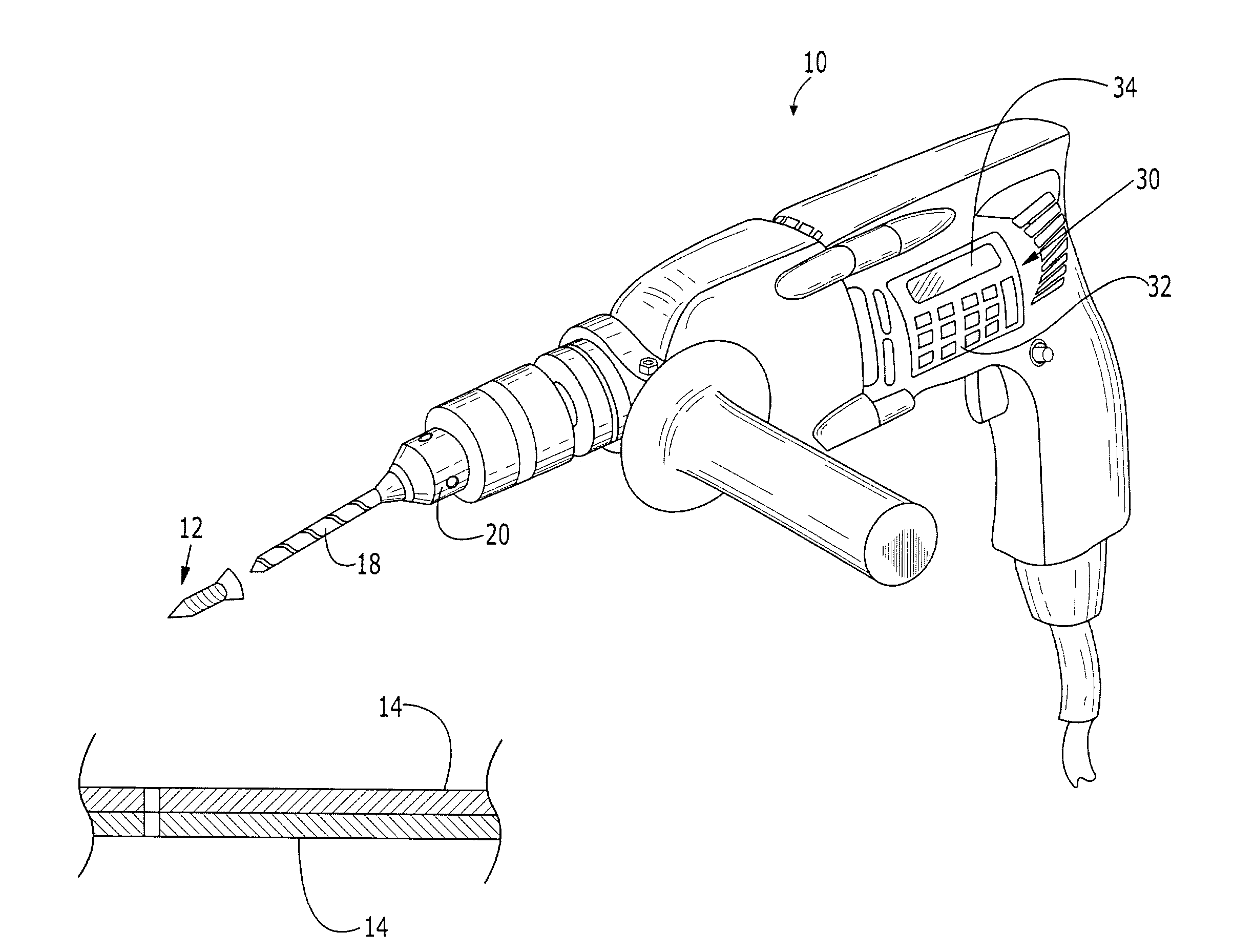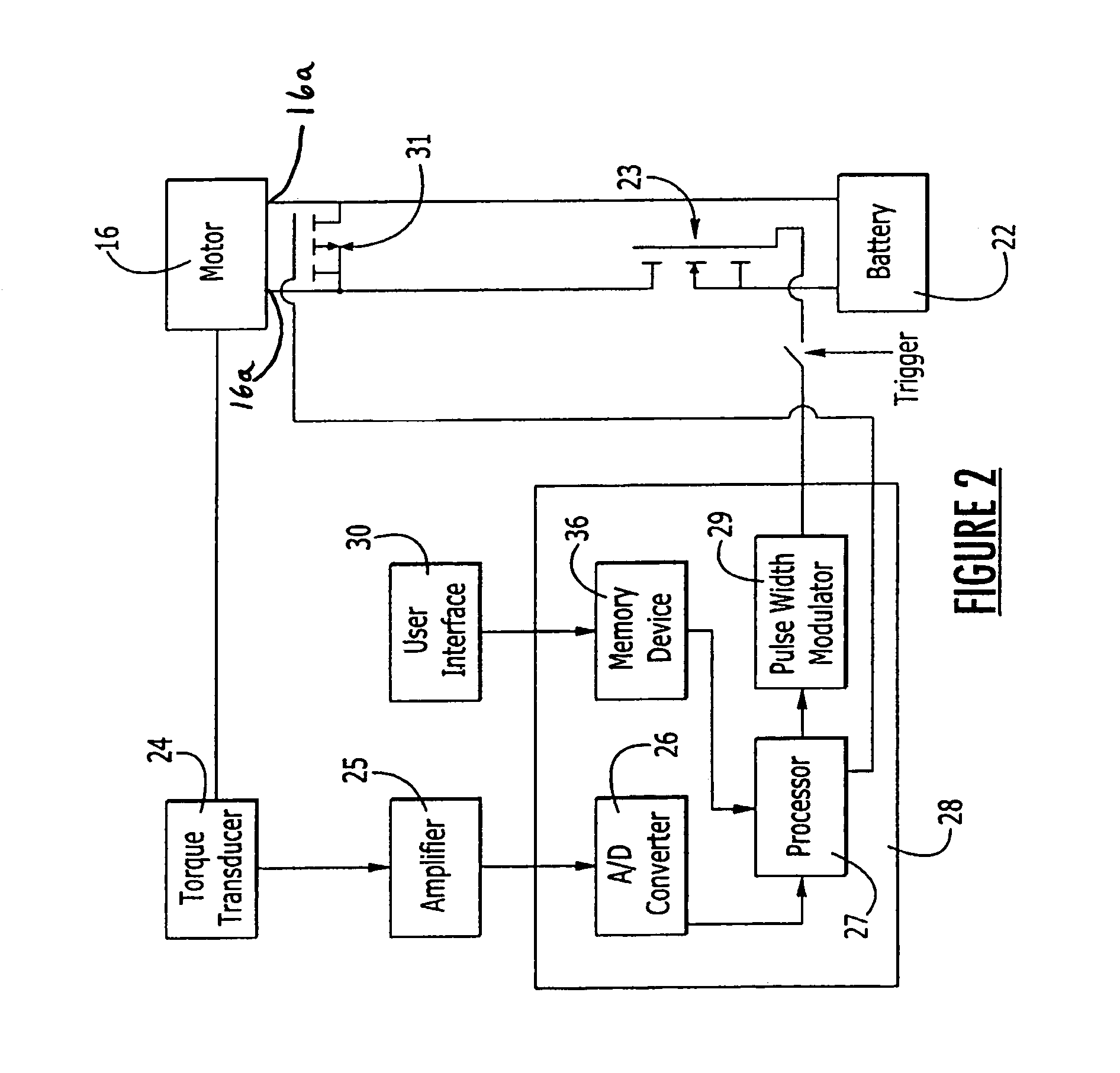[0008]An improved torque tool and an associated method are provided according to the present invention which apply various operator-defined levels of torque to a threaded fastener. According to one aspect of the present invention, a portable, battery powered torque tool and an associated installation method are provided which control the motor so as to slow further advancement of the threaded fastener once the torque that has been applied to the threaded fastener has reached a predefined threshold. According to another aspect of the present invention, a torque tool and associated installation method are provided for receiving and monitoring a measure of torque applied to a threaded fastener at more frequent intervals once the torque applied to the threaded fastener has reached a predefined threshold. As such, the torque tool and associated installation methods of these aspects of the present invention permit a more controlled installation of the threaded fastener to a desired final torque value, typically defined by the operator. A method of defining a
mathematical relationship between a first measure provided by a torque
transducer of torque applied to a threaded fastener and a second measure provided by a torque measurement
reference device of torque applied to the threaded fastener is also provided such that the measure of torque provided by the torque transducer can be calibrated, thereby further improving the consistency and accuracy with which the torque tool installs a threaded fastener.
[0009]According to one aspect of the present invention, a portable, battery operated torque tool and an associated installation method are provided for slowing further advancement of the threaded fastener once the torque applied to the threaded fastener has reached a predefined threshold. In this regard, power is provided to the portable torque tool with at least one battery. In response, the portable torque tool and, in particular, the motor of the portable torque tool applies torque to the threaded fastener to thereby advance the threaded fastener. A measure of the torque applied to the threaded fastener is obtained, such as by a torque transducer, and is repeatedly reviewed to determine when the torque applied to a threaded fastener has reached a predefined threshold. In this regard, the measure of torque applied to a threaded fastener is provided to a
processing element that at least partially controls operation of the motor. The
processing element receives the measure of torque applied to a threaded fastener and determines when the applied torque has reached the predefined threshold. While this threshold may be defined in various manners, the predefined threshold of one embodiment is a predefined percentage, such as 50%, of a desired final torque value. Upon determining that the torque applied to a threaded fastener has reached the predefined threshold, further advancement of the threaded fastener may be slowed such as by appropriate control of the motor by the
processing element. By slowing further advancement of the threaded fastener, the torque tool and associated installation method can more precisely halt further advancement of the threaded fastener upon reaching the desired final torque value, thereby avoiding over-tightening of the threaded fastener. By providing power to the motor with one or more batteries, however, the torque tool is readily portable and is not tethered to a stationary power supply.
[0010]According to another aspect of the present invention, a torque tool and associated method for installing a threaded fastener are provided that receive and process the measure of torque applied to the threaded fastener at more frequent intervals once the torque applied to the threaded fastener has reached a predefined threshold. According to this aspect, torque is applied to a threaded fastener, such as by a motor, and the measure of torque applied to a threaded fastener is provided, such as by a torque transducer to a
processing element that at least partially controls operation of the motor. From the measure of torque applied to the threaded fastener, it can be determined when the torque applied to the threaded fastener has reached the predefined threshold, such as a predetermined percentage of a desired final torque value. Once the torque applied to a threaded fastener has reached the predefined threshold, the measure of torque applied to the threaded fastener may be received or sampled at more frequent intervals. By sampling the measure of torque applied to a threaded fastener more frequently, the torque tool and associated installation method of this aspect of the present invention can again more readily halt further advancement of the threaded fastener upon application of the desired final torque value, thereby further avoiding over-tightening of the threaded fastener. As before, the torque tool of this aspect of the present invention may be powered by at least one battery, thereby similarly increasing the portability of the torque tool.
[0012]According to another aspect of the present invention, a method is provided of calibrating the measure of torque applied to a threaded fastener that is provided by a torque transducer. In this regard, at least one threaded fastener is repeatedly installed with different amounts of torque applied to the threaded fastener(s) during at least two of the installations. The torque applied to the threaded fastener during each installation is measured by both the torque transducer and a torque measurement
reference device. The torque transducer will be an integral part of the torque tool during normal operation, while the torque measurement reference device is utilized to provide a
reference measurement of the torque applied to the threaded fastener for purposes of calibrating the torque transducer. As such, the measure of torque applied to the threaded fastener that is provided by the torque measurement reference device is generally more precise than that provided by the torque transducer. The torque transducer and the torque measurement reference device provide first and second measures, respectively, of the torque applied during each installation. Typically, the torque measurement reference device provides a
direct measure of the torque, such as in Newton meters or the like. Alternatively, the torque transducer generally provides a value indirectly representative of the torque. In order to relate the value provided by the torque transducer to the torque that has been applied to the threaded fastener, a
mathematical relationship is determined that relates the first and second measures of torque provided by the torque transducer and the torque measurement reference device, respectively. While the mathematical relationship may be defined in various ways, a
regression analysis, such as a
linear regression analysis, may be employed to mathematically relate the first and second measures of the torque. By appropriately relating the first and second measures of torque provided by the torque transducer and torque measurement reference device, respectively, the measure of torque provided by the torque transducer during normal operation of the torque tool can be accurately translated into actual values of torque that have been applied to the threaded fastener.
 Login to View More
Login to View More  Login to View More
Login to View More 


